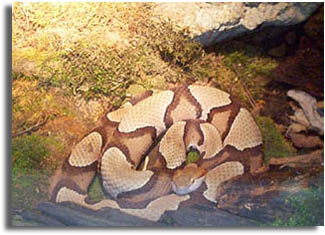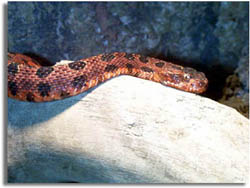|
Mark Hatfield, National Wild Turkey Federation regional biologist,
explained, "Snake encounters typically occur within the two hours after
sunrise when snakes are warming up to the morning temperatures. This is the
time when hunters are usually distracted with a turkey and have settled
into a spot."
 Many hunters just assume any snake is a venomous snake, but the majority of
snakes out there are harmless to people. Even venomous snakes aren't
dangerous unless provoked and the chances of being bitten are low. Many hunters just assume any snake is a venomous snake, but the majority of
snakes out there are harmless to people. Even venomous snakes aren't
dangerous unless provoked and the chances of being bitten are low.
Chris Phillips, an assistant professional scientist with the Illinois
Natural History Survey, doesn't mind snakes. He goes out of his way to
debunk snakes myths and has been fighting an uphill battle to educate
people about them.
"Even if presented with physical evidence contrary to popular belief,
people are reluctant to change their minds about these creatures," he said.
Unfortunately, most snakes act and react in a similar manner. Snakes that
coil up and twitch their tail are often assumed to be rattlesnakes. In
fact, many snakes will behave this way when cornered. According to
Phillips, water snakes and western hognose snakes are commonly
misidentified and killed because their appearance or behavior resembles
that of venomous snakes.
Phillips could not give an exact figure on what percentage of snakes out
there are venomous versus non-venomous because the numbers will vary from
year to year and between different regions of the country.
 "If a turkey hunter encounters a snake, the chances it is harmless are far
greater, perhaps more than two or three times greater, than if it is a
venomous one. Plus, a venomous snake's response to a person is to be
invisible or leave when found. They do not want to be found or noticed," he
said. Phillips cites his own research, where he radio-tagged rattlesnakes
to track their movement. Phillips would often come within striking distance
of these rattlers, yet the snakes would not reveal themselves or act
aggressive. "If a turkey hunter encounters a snake, the chances it is harmless are far
greater, perhaps more than two or three times greater, than if it is a
venomous one. Plus, a venomous snake's response to a person is to be
invisible or leave when found. They do not want to be found or noticed," he
said. Phillips cites his own research, where he radio-tagged rattlesnakes
to track their movement. Phillips would often come within striking distance
of these rattlers, yet the snakes would not reveal themselves or act
aggressive.
"Snakes are ambush predators, and venom is a very expensive commodity.
Venom is meant for immobilizing prey, not for defense. Snakes must be
prodded into biting a non-prey item. Biting a person is the last measure,
for a snake. If a hunter strikes, sits on, steps on or picks up the snake,
they may get bitten. The best thing is to just leave it alone," he added.
"Most stories that are told about aggressive snakes come from those who
have been bitten by snakes and are too embarrassed to admit they've done
something foolish by picking it up, harassing it or trying to step on it."
Phillips advised.
Identifying Snakes
There are two families of venomous snakes native to the United States. The
pit vipers, of the family Crotalidae, which include
rattlesnakes,
copperheads and
cottonmouths, make up the vast majority of venomous snakes
in the country. Pit vipers get their common name from a small heat-sensing
pit between the eye and nostril that allows the snake to sense prey at
night.
The other family of venomous snakes is Elapidae, which includes two species
of coral snakes found chiefly in the southern states. They are related to
the much more dangerous Asian cobras and kraits. Coral snakes have small
mouths and short teeth, which give them less efficient venom delivery than
pit vipers. People bitten by coral snakes lack the fang marks of pit
vipers, sometimes making the bite hard to detect.
Here are a few guidelines to identify most venomous snakes.
Pit Vipers
- Head Shape: large, triangular shaped head and much narrower neck
- Pupil Shape: vertical or elliptical pupil, like a cat's eye
- Presence of Rattles: rattlesnakes only
Coral Snakes
- Head Shape: slender
- Pupil Shape: round
Coral snakes share many characteristics of non-venomous snakes. There are
many variants on sayings that will help one remember the difference between
a coral snake and a harmless king snake or milk snake.
"Red on yellow, kill a fellow; red on black, venom lack."
"Red next to black is safe for Jack; red next to yellow will kill any
fellow."
"Red on yellow, dangerous fellow; red on black, friend to Jack"
"Red on yellow, kill a fellow; red on black, won't hurt Jack"
All tell the same warning about the color pattern for North American coral
snakes. However, identifying venomous snakes isn't easy; there are numerous
exceptions to the rules above, especially when dealing with coral snakes.
Characteristics such as head shape are subjective to the observer;
something that appears triangular to one person may seem slender to
another. And some nonvenomous water snakes have characteristics that make
it easy to confuse them with venomous snakes. Also, identifying some of
these characteristics, such as noting the pit sensors, requires close
examination of the snake, something we recommend you avoid.
The Venomous Facts
It seems that for every myth that exists for nonvenomous snakes, there is
just as much misinformation about venomous snakes. Here are the facts from
the Centers for Disease Control:
● 7,000 venomous snake bites are reported annually in the United States. 15
fatalities result, placing the chance of survival at roughly 499 out of 500
(99.8 percent survival).
● Approximately 3,000 are classed as illegitimate, meaning these bites
occurred while the victim was handling the snake.
● 85 percent of the bites are below the knee.
● 50 percent of bites are dry. Squeezing the venom glands is a voluntary
reflex. Strikes are generally defensive actions, it is estimated that no
venom is purposely injected about half the time.
Recognizing a Bite
The stabbing strike of a pit viper can be recognized by one or two definite
puncture wounds. There will be intense, burning pain and swelling around
the holes, if venom is present.
The coral snake bites and holds. There will be little pain, but the victim
will begin to lose control of all reflexes. Drooping eyelids will probably
be the first sign of coral snake venom.
The NWTF recommends these simple rules if you've been bitten by a venomous
snake:
● Remain calm - Remember that there is an excellent chance for survival, and
in most cases, there is plenty of time.
● Remove jewelry - Swelling can progress rapidly. Rings, watches and
bracelets can become a real problem if not removed quickly.
● Mark the time - The progress of symptoms and timing will help doctors treat
your snake bite.
● Keep the stricken limb below the heart to slow the progress of the venom.
● Get to a hospital as quickly as possible -Anti-venom serum is the only sure
cure for snake venom. Because some people are allergic to the serum, it
should only be given in a fully equipped medical facility.
● In case of a coral snake bite, do pull the snake off immediately - Corals'
fangs are relatively small, and they have to work at getting venom into the
wound.
Turkey Hunting and Snakes
Hatfield suggested that turkey hunters be cautious of sunning spots where
snakes are likely to be found. These spots are places where snakes soak up
the warmth of the sun to speed up their metabolism. He emphasized that
hunters need to be keenly aware of their surroundings before they sit down.
"South-facing slopes, root balls, stumps and bases of rock piles are common
places where snakes will seek out to warm themselves. Coincidentally, these
are also places where hunters are likely to sit to call or gain a vantage
point on turkeys." Hatfield explained, "The next thing that hunters should
avoid is grabbing, striking or picking up the snake. Handling snakes,
especially venomous ones, should be left to the experts."
If hunters wish to add some insurance, wearing snake chaps will
significantly lessen the chances of a penetrating bite as most bites are
below the knee.
"If a turkey hunter encounters a snake, take two steps back and calmly walk
around it. Snakes, in general, can only strike at a distance of 1/2 to 2/3
the length of their body," said Dr. James Earl Kennamer, NWTF senior vice
president for conservation programs. "Taking two steps back will
significantly reduce the chances of a bite by putting a safe distance
between the snake and the hunter."
Enjoy the hunt, but keep a calm eye out for the snakes that inhabit turkey
country.
|